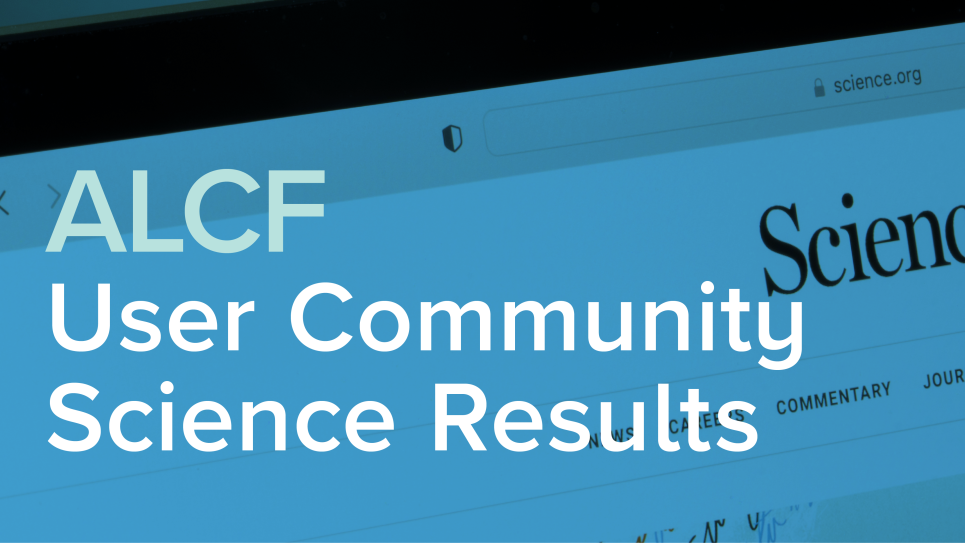
ALCF User Results: Recent publications cover catalysis, electronic excitation of DNA, extreme climate phenomena, differential equations
Learn about some of the recent publications produced by the ALCF user community.
The ALCF user community continually pushes the boundaries of scientific computing, producing groundbreaking studies in areas ranging from chemistry and engineering to physics and materials science. Below, we highlight some of the recent results published by ALCF users in peer-reviewed journals.
“Hydrogen Evolution on Electrode-Supported Ptn Clusters: Ensemble of Hydride States Governs the Size Dependent Reactivity,” Angewandte Chemie (March 2023), John Wiley and Sons
ALCF principal investigator (PI): Philippe Sautet, University of California, Los Angeles
This work reports the size-dependent activity and stability of supported Pt1,4,7,8 for electrocatalytic hydrogen evolution reaction, and show that clusters outperform polycrystalline Pt in activity, with size-dependent stability. To understand the size effects, the authors carried out DFT calculations on ALCF resources to study the structural fluxionality under varying potentials. Their calculations showed that the clusters can reshape under H coverage and populate an ensemble of states with diverse stoichiometry, structure, and thus reactivity. Both experiment and theory suggest that electrocatalytic species are hydridic states of the clusters (≈2 H/Pt). An ensemble-based kinetic model reproduces the experimental activity trend and reveals the role of metastable states. The stability trend is rationalized by chemical bonding analysis. The resulting joint study demonstrates the potential- and adsorbate-coverage-dependent fluxionality of subnano clusters of different sizes and offers a systematic modeling strategy to tackle the complexities.
"Electronic Excitation Response of DNA to High-Energy Proton Radiation in Water," Physical Review Letters (March 2023), APS
ALCF PI: Yosuke Kanai, University of North Carolina at Chapel Hill
The lack of molecular-level understanding for the electronic excitation response of DNA to charged particle radiation, such as high-energy protons, remains a fundamental scientific bottleneck in advancing proton and other ion beam cancer therapies. In particular, the dependence of different types of DNA damage on high-energy protons represents a significant knowledge void. The authors use ALCF supercomputers to employ first-principles real-time time-dependent density functional theory simulation to unravel the quantum-mechanical details of the energy transfer from high-energy protons to DNA in water. The calculations reveal that protons deposit significantly more energy onto the DNA sugar-phosphate side chains than onto the nucleobases, and greater energy transfer is expected onto the DNA side chains than onto water. As a result of this electronic stopping process, highly energetic holes are generated on the DNA side chains as a source of oxidative damage.
“Projected Changes in Extreme Streamflow and Inland Flooding in the Mid-21st Century over Northeastern United States Using Ensemble WRF-Hydro Simulations,” Journal of Hydrology: Regional Studies (March 2023), Elsevier
ALCF PI: Rao Kotamarthi, Argonne National Laboratory
The authors leverage ALCF resources to investigate the potential impacts of climate change on precipitation, streamflow, and inland flooding in the Northeastern United States during the mid-21st century. Dynamically downscaled climate projections from three global climate models for historical (1995–2004) and future (2045–2054) periods under business-as-usual scenarios were used to force the hydrologic model WRF-Hydro at 200-meter resolution and create ensemble hydrologic simulations. Additionally, an extreme value model was developed to project the risks associated with low-frequency hydrologic events.
"Learning Subgrid-Scale Models with Neural Ordinary Differential Equations,” Computers and Fluids (May 2023), Elsevier
ALCF PI: Emil M. Constantinescu, Argonne National Laboratory
In this work, after having leveraged ALCF resources, the authors propose a new approach to learning the subgrid-scale model when simulating partial differential equations (PDEs) solved by the method of lines and their representation in chaotic ordinary differential equations, based on neural ordinary differential equations (NODEs). Solving systems with fine temporal and spatial grid scales is an ongoing computational challenge, and closure models are generally difficult to tune. Machine learning approaches have increased the accuracy and efficiency of computational fluid dynamics solvers. In this approach neural networks are used to learn the coarse- to fine-grid map, which can be viewed as subgrid-scale parameterization. The authors propose a strategy that uses the NODE and partial knowledge to learn the source dynamics at a continuous level. Their method inherits the advantages of NODEs and can be used to parameterize subgrid scales, approximate coupling operators, and improve the efficiency of low-order solvers. Numerical results with the two-scale Lorenz 96 ODE, the convection–diffusion PDE, and the viscous Burgers’ PDE are used to illustrate this approach.
For a full list, see our publications webpage. If you have any new publications that used ALCF resources, please let us know by sending an email to pubs@alcf.anl.gov.